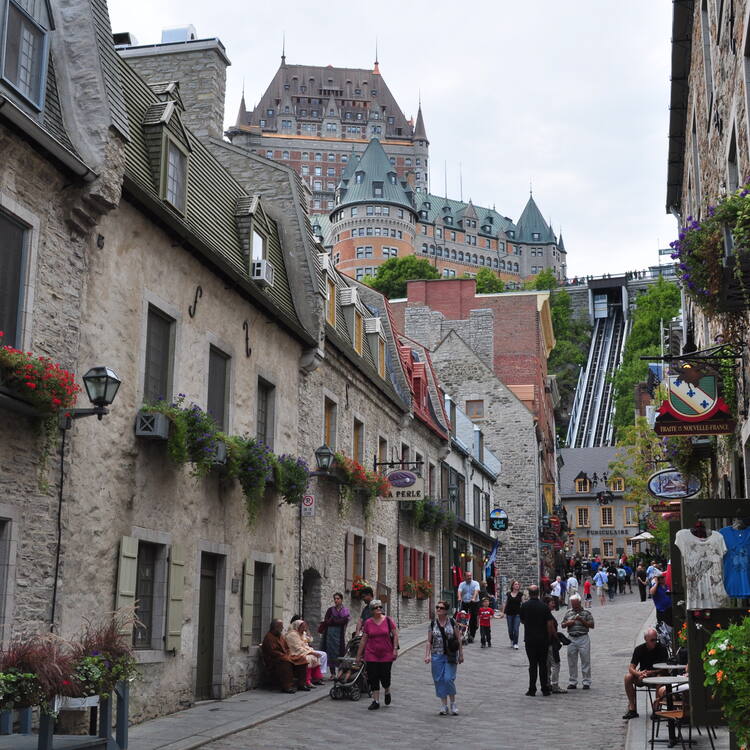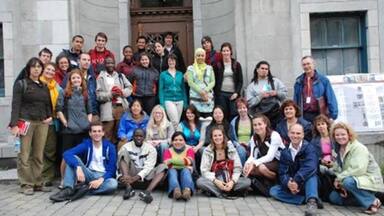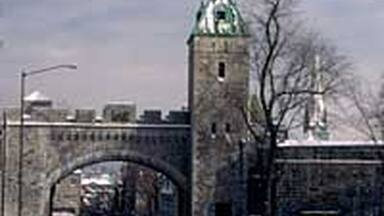Historic District of Old Québec
Historic District of Old Québec
Québec was founded by the French explorer Champlain in the early 17th century. It is the only North American city to have preserved its ramparts, together with the numerous bastions, gates and defensive works which still surround Old Québec. The Upper Town, built on the cliff, has remained the religious and administrative centre, with its churches, convents and other monuments like the Dauphine Redoubt, the Citadel and Château Frontenac. Together with the Lower Town and its ancient districts, it forms an urban ensemble which is one of the best examples of a fortified colonial city.
Description is available under license CC-BY-SA IGO 3.0
Arrondissement historique du Vieux-Québec
Fondée par l'explorateur français Champlain au début du XVIIe siècle, Québec demeure la seule ville d'Amérique du Nord à avoir conservé ses remparts qui regroupent de nombreux bastions, portes et ouvrages défensifs ceinturant toujours le Vieux-Québec. La Haute-Ville, située au sommet de la falaise, centre religieux et administratif, avec ses églises, ses couvents et autres monuments comme la redoute Dauphine, la Citadelle et le Château Frontenac, et la Basse-Ville, avec ses quartiers anciens, forment un ensemble urbain qui est un des meilleurs exemples de ville coloniale fortifiée.
Description is available under license CC-BY-SA IGO 3.0
الدائرة التاريخية للكيبيك القديم
أسّس المستكشف الفرنسي شامبلان مدينة الكيبيك في مطلع القرن السابع عشر وهي لا تزال المدينة الوحيدة في أميركا الشمالية التي حافظت على أسوارها المؤلفة من عدة مواقع محصنّة وأبواب ودعائم دفاعية تلّف الكيبيك القديمة حتى يومنا هذا. وتضم المدينة العليا التي تقع في أعلى الجرف وتمثّل مركزاً دينياً وإدارياً مهماً مجموعة من الكنائس والأديرة وغيرها من المباني كمعقل دوفين والقلعة وقصر فرونتوناك، وهي تشكّل، مع المدينة السفلى وأحيائها القديمة، مجموعة حضرية لعلّها أحد أفضل الأمثلة عن المدينة المستعمرة المحصنّة.
source: UNESCO/CPE
Description is available under license CC-BY-SA IGO 3.0
魁北克古城区
魁北克城是由法国探险家查普伦(Champlain)在17世纪早期修建的,是北美唯一保存有城墙以及大量的堡垒、城门、防御工事的城市,这些工程至今仍环绕着魁北克古城。上城区建立在悬崖上,至今仍然是宗教和行政中心。城区内有教堂、女修道院和一些建筑物,如王妃城堡、要塞和弗隆特纳克堡(Dauphine Redoubt)。上城区、下城区和老城区一起构成了城市的整体,这是具有最完备防御系统的殖民城市之一。
source: UNESCO/CPE
Description is available under license CC-BY-SA IGO 3.0
Исторический район города Квебек
Квебек был основан французским исследователем Шампленом в начале XVII в. Это единственный город в Северной Америке, сохранивший валы с множеством бастионов, ворот и оборонительных устройств, и сейчас еще окружающих Старый Квебек. Верхний город, построенный на утесе, остался религиозным и административным центром с церквями, монастырями и другими памятниками – редутом Дофин, цитаделью, и гостиницей Шато-Фронтенак. Вместе с Нижним городом и его старыми кварталами это формирует городской ансамбль, который является одним из лучших примеров колониального укрепленного города.
source: UNESCO/CPE
Description is available under license CC-BY-SA IGO 3.0
Distrito histórico del antiguo Quebec
Fundada a comienzos del siglo XVII por el explorador francés Champlain, la ciudad vieja de Quebec está rodeada por una muralla con múltiples baluartes, puertas y fortificaciones, y es la única ciudad de América del Norte que la ha conservado intacta. La Ciudad Alta, edificada en la cima del acantilado, es aún el centro religioso y administrativo y posee numerosas iglesias, conventos y otros monumentos como el reducto Dauphine, la ciudadela y el castillo Frontenac. Junto con los barrios viejos de la Ciudad Baja, forma un conjunto urbano que es un excelente ejemplo una ciudad colonial fortificada.
source: UNESCO/CPE
Description is available under license CC-BY-SA IGO 3.0
ケベック旧市街の歴史地区
ケベック州南部の都市。人口の80%はフランス系住民。フランスの北米植民地として発展したこの地を巡る17世紀以後の英仏間の確執が、今なお色濃く反映している。旧市街は城壁で囲まれ、市のシンボルである旧総督邸シャトー・フロントナックがセント・ローレンス川沿いに建ち、その足元には旧市街の中心広場プラス・ダルムが広がっている。南の高台には、七年戦争後イギリス軍が築いた星型の城塞(シタデル)がそびえている。source: NFUAJ
Historisch district van Oud Quebec
Quebec werd in de vroege 17e eeuw gesticht door de Franse ontdekkingsreiziger Champlain. Het is de enige Noord-Amerikaanse stad waarvan de stadsmuren bewaard zijn gebleven, samen met de vele bastions, poorten en defensieve werken die het Oude Quebec nog steeds omringen. De Bovenstad – gebouwd op de klif – is het religieuze en administratieve centrum gebleven. Er zijn kerken, kloosters en andere monumenten te vinden, zoals de Dauphine Redoubt, de Citadel en Château Frontenac. Samen met de Benedenstad en de oude wijken vormt het een van de beste voorbeelden van een versterkte koloniale stad.
Source: unesco.nl
Outstanding Universal Value
Brief synthesis
Founded in the 17th century, Québec City bears eloquent testimony to important stages in the European settlement of the Americas: it was the capital of New France and, after 1760, of the new British colony. The Historic District of Old Québec is an urban area of about 135 hectares. It is made up to two parts: the Upper Town, sitting atop Cap Diamant and defended by fortified ramparts, a citadel, and other defensive works, and the Lower Town, which grew up around Place Royale and the harbour. A well-preserved integrated urban ensemble, the historic district is a remarkable example of a fortified colonial town, and unique north of Mexico.
Criterion (iv) : A coherent and well-preserved urban ensemble, the Historic District of Old Québec is an exceptional example of a fortified colonial town and by far the most complete north of Mexico.
Criterion (vi) : Québec, the former capital of New France, illustrates one of the major stages in the European settlement of the colonization of the Americas by Europeans.
Integrity
The boundaries of the property encompass all necessary elements to express the outstanding universal value of the Historic District of Old Québec. The historic centre, confined within the current boundaries of the district, is the product of more than four centuries of history. During this period, the fortified town retained the integrity of its essential historical components, particularly from the standpoint of its architecture and urban spatial organization. The property is of adequate size (135 ha) to ensure the complete representation of the features and processes which convey the property’s significance. It has not suffered unduly from adverse effects of development and/or neglect. Over the years, many integration, restoration, rehabilitation, redevelopment and protection and stabilization projects have been carried out. Overall, the projects undertaken in the Historic District of Old Québec have not compromised its integrity.
Authenticity
The Historic District of Old Québec is authentic in terms of its form and design, materials and substance, and location and setting. Since the time of its inscription, the property has changed considerably, particularly with respect to the organization of its historic urban landscape. However, the attributes of the property express its outstanding universal value in a truthful and credible manner.
Protection and management requirements
The Historic District of Old Québec enjoys strong legal protection and the support of all levels of government concerned. An intergovernmental committee, called the Comité de concertation du patrimoine de Québec, was created to coordinate the activities of the different levels of government.
The area of the Historic District of Old Québec, designated by the provincial authority as the site patrimonial du Vieux-Québec (Old Québec heritage site), is legally protected under the Province of Quebec’s Cultural Property Act, which was adopted in 1963. Its boundaries were established by provincial decree in 1964.
Since its inclusion on the World Heritage List in 1985, a number of buildings in Old Québec have been added to the list of properties protected under the Cultural Property Act, including the Site historique et archéologique de l’Habitation-Samuel-De Champlain, the Ursuline Convent of Québec and the archaeological reference collection of Place Royale.
The City of Québec assumes all management responsibilities under its jurisdiction relating to land use and urban planning (zoning bylaws). Moreover, the Règlement sur la politique de consultation publique (bylaw on the public consultation policy) adopted in 2007 stipulates that the Conseil de quartier Vieux-Québec–Cap-Blanc–Colline-Parlementaire (district council) must be consulted before any amendments are made to urban planning and traffic bylaws. Furthermore, any construction, renovation, restoration and signage interventions in Old Québec must have the prior authorization of the Commission d’urbanisme et de conservation of the City of Québec.
The Quebec government and the City of Québec routinely enter into cultural development agreements making it possible to offer grant programs and major financial contributions to support the restoration of the heritage buildings in Old Québec.
The federal government, through various departments and Parks Canada, manages a large number of heritage properties. All federal departments, except Crown corporations, are required to comply with the Treasury Board Policy on the Management of Real Property. The Federal Heritage Buildings Review Office (FHBRO) of Parks Canada is mandated to assist them in this task. The Department of National Defence, which is responsible for the Citadel, and Public Works and Government Services Canada play a role in ensuring heritage preservation in the Historic District of Old Québec. As the owner and manager of national historic sites of Canada, Parks Canada invests in the preservation and presentation of its properties, and consequently in the historic district. With nearly 70 persons, places and events of national historic significance under its responsibility, the Agency helps to raise public awareness concerning the significance of the Historic District of Old Québec.
Special attention will be given over the long term to monitoring proposed changes and additions to the property that could, for example, impact its visual integrity and appropriate measures will continue to be implemented to ensure the protection, integrity and authenticity of the property.



